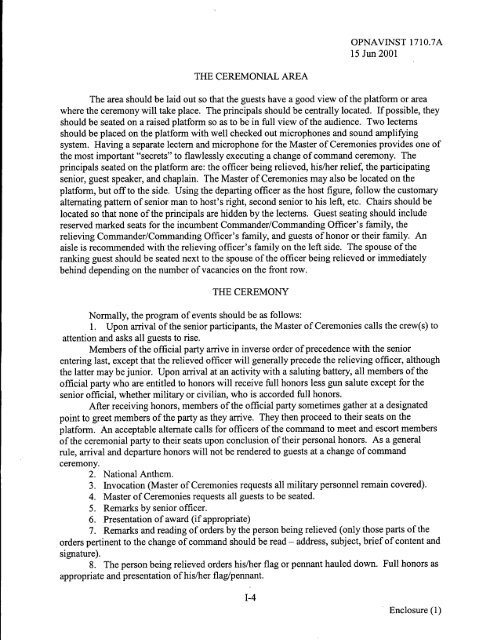OPNAVINST 1710.7A - Historic Naval Ships Association
OPNAVINST 1710.7A - Historic Naval Ships Association
OPNAVINST 1710.7A - Historic Naval Ships Association
You also want an ePaper? Increase the reach of your titles
YUMPU automatically turns print PDFs into web optimized ePapers that Google loves.
<strong>OPNAVINST</strong><br />
15 Jun 2001<br />
171O.7A<br />
THE CEREMONIAL<br />
AREA<br />
The area should be laid out so that the guests have a good view of the platform or area<br />
where the ceremony will take place. The principals shoulci be centrally located. If possible, they<br />
should be seated on a raised platform so as to be in full view of the audience. Two lecterns<br />
should be placed on the platform with well checked out microphones and sound amplifying<br />
system. Having a separate lectern and microphone for the Master of Ceremonies provides one of<br />
the most important “secrets” to flawlessly executing a change of command ceremony. The<br />
principals seated on the platform are: the officer being relieved, his/her relief, the participating<br />
senior, guest speaker, and chaplain. The Master of Ceremonies may also be located on the<br />
platform, but off to the side. Using the departing officer as the host figure, follow the customary<br />
alternating pattern of senior man to host’s right, second senior to his left, etc. Chairs should be<br />
located so that none of the principals are hidden by the lecterns. Guest seating should include<br />
reserved marked seats for the incumbent Commander/Comrnanding Officer’s family, the<br />
relieving Commander/Commanding Officer’s family, and guests of honor or their family. An<br />
aisle is recommended with the relieving officer’s family on the left side. The spouse of the<br />
ranking guest should be seated next to the spouse of the officer being relieved or immediately<br />
behind depending on the number of vacancies on the front row.<br />
THE CEREMONY<br />
Normally, the program of events should be as follows:<br />
1. Upon arrival of the senior participants, the Master of Ceremonies calls the crew(s) to<br />
attention and asks all guests to rise.<br />
Members of the official party arrive in inverse order of precedence with the senior<br />
entering last, except that the relieved officer will generally precede the relieving officer, although<br />
the latter may be junior. Upon arrival at an activity with a saluting battery, all members of the<br />
official party who are entitled to honors will receive full honors less gun salute except for the<br />
senior official, whether military or civilian, who is accorded full honors.<br />
After receiving honors, members of the official party sometimes gather at a designated<br />
point to greet members of the party as they arrive. They then proceed to their seats on the<br />
platform. An acceptable alternate calls for officers of the command to meet and escort members<br />
of the ceremonial party to their seats upon conclusion of th~eirpersonal honors. As a general<br />
rule, arrival and departure honors will not be rendered to guests at a change of command<br />
ceremony.<br />
2. National Anthem.<br />
3, Invocation (Master of Ceremonies requests all military personnel remain covered).<br />
4. Master of Ceremonies requests all guests to be seated.<br />
5. Remarks by senior officer.<br />
6. Presentation of award (if appropriate)<br />
7. Remarks and reading of orders by the person being relieved (only those parts of the<br />
orders pertinent to the change of command should be read – address, subject, brief of content and<br />
signature).<br />
8. The person being relieved orders his/her flag or pennant hauled down. Full honors as<br />
appropriate and presentation of his/her flag/pennant.<br />
I-4<br />
Enclosure (1)

















